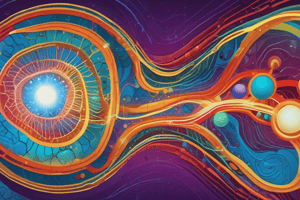Podcast
Questions and Answers
What is the primary role of ATP in cells?
What is the primary role of ATP in cells?
- To serve as the energy currency (correct)
- To store genetic information
- To stabilize cell membranes
- To transport nutrients across the cell
Which stage of cellular respiration does not require oxygen?
Which stage of cellular respiration does not require oxygen?
- Krebs cycle
- Glycolysis (correct)
- Electron transport chain
- Oxidative phosphorylation
Where does the Krebs cycle occur in the cell?
Where does the Krebs cycle occur in the cell?
- Nucleus
- Endoplasmic reticulum
- Mitochondria (correct)
- Cytoplasm
Which statement about oxidative phosphorylation is correct?
Which statement about oxidative phosphorylation is correct?
What are the end products of glycolysis?
What are the end products of glycolysis?
What byproduct is produced during the process of aerobic respiration when electrons combine with oxygen?
What byproduct is produced during the process of aerobic respiration when electrons combine with oxygen?
Which of the following mechanisms is NOT involved in the regulation of metabolic pathways for ATP production?
Which of the following mechanisms is NOT involved in the regulation of metabolic pathways for ATP production?
What is the primary energy source produced during photosynthesis?
What is the primary energy source produced during photosynthesis?
Why is understanding bioenergetics important in the medical field?
Why is understanding bioenergetics important in the medical field?
What essential byproduct is produced during photosynthesis that is crucial for aerobic respiration?
What essential byproduct is produced during photosynthesis that is crucial for aerobic respiration?
Flashcards are hidden until you start studying
Study Notes
Bioenergetics Overview
- Study of energy flow in living systems, emphasizing energy conversion in cells.
- Key molecule: ATP (adenosine triphosphate), serving as energy currency in cells.
ATP and Energy Production
- ATP stores energy in high-energy phosphate bonds; energy is released upon bond breakdown.
- ATP production occurs primarily through cellular respiration, which converts nutrients into ATP while generating waste.
Stages of Cellular Respiration
-
Glycolysis:
- Occurs in the cytoplasm, breaking glucose into two pyruvate molecules.
- Produces a small amount of ATP and NADH; does not require oxygen (anaerobic).
- First step in energy extraction from glucose, crucial for both aerobic and anaerobic processes.
-
Krebs Cycle:
- Takes place in the mitochondria; processes pyruvate from glycolysis.
- Generates electron carriers NADH and FADH2 and a small amount of ATP; requires oxygen (aerobic).
- Releases carbon dioxide as waste and produces high-energy electrons for the next respiration stage.
-
Oxidative Phosphorylation:
- Final stage, occurring in the inner mitochondrial membrane.
- NADH and FADH2 donate electrons to the electron transport chain, which consists of protein complexes.
- Energy released from electron movement pumps protons across the mitochondrial membrane, creating a proton gradient.
- Protons flow back through ATP synthase, synthesizing ATP from ADP and inorganic phosphate; water is produced as a byproduct.
Regulation of Metabolic Pathways
- Regulation is vital for ATP production in line with cellular energy demands.
- Enzymes play a crucial role, regulated by allosteric interactions, feedback inhibition, and covalent modification.
Photosynthesis
- Essential bioenergetic process in plants, converting light energy into chemical energy stored in glucose.
- Produces oxygen as a byproduct, vital for aerobic respiration.
Importance of Bioenergetics
- Understanding bioenergetics is key to grasping energy management in living organisms.
- Relevant in medical fields due to implications of energy metabolism disruptions in diseases like diabetes and cancer.
Studying That Suits You
Use AI to generate personalized quizzes and flashcards to suit your learning preferences.




